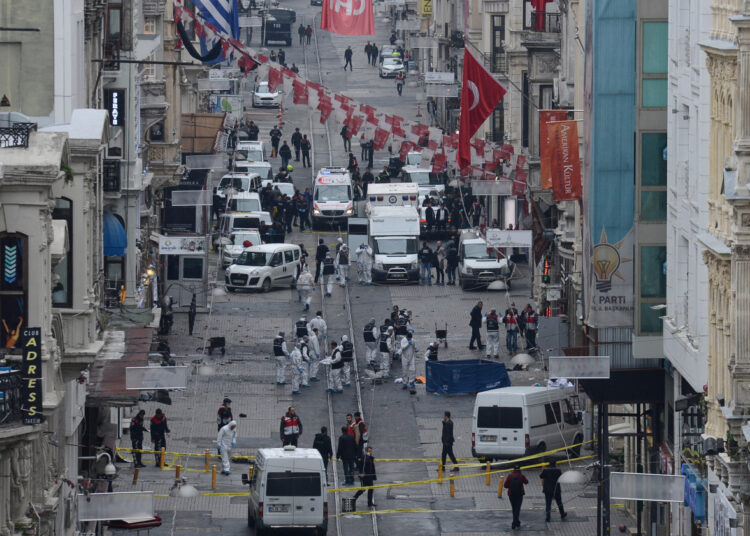Abdullah Bozkurt/Stockholm
Despite evidence of complicity in a suicide attack that killed foreigners including three Israeli citizens in Istanbul in 2016, Turkey’s top court tossed the convictions of ISIS terrorists on charges of murder and attempting to overturn the constitutional order, imposing lighter sentences on lesser charges amid what critics call a lenient judicial approach to radical Islamist groups in Turkey.
The Supreme Court of Appeals (Yargıtay) in a ruling dated July 1, 2024, overturned the aggravated life sentences handed down to members of an ISIS cell based in Gaziantep who were responsible for the March 19, 2016, suicide bombing on İstiklal Avenue in Istanbul. The attack, carried out by 24-year-old ISIS militant Mehmet Öztürk, killed three Israeli citizens — Simha Simon Demri, Yonathan Suher and Avraham Godman — as well Iranian national Ali Rıza Khalman, and wounded 44 others.
The bombing took place near the Greek Consulate, shattering a peaceful spring morning in Istanbul’s most crowded tourist hub. What was first seen as a random ISIS explosion later proved to be a calculated assassination mission targeting Israeli tourists, meticulously planned and executed under the command of a Gaziantep-based ISIS network operating freely inside Turkey.
According to intelligence reports, Öztürk first crossed into Syria in 2013 through the Çobanbey (Al-Rai) border gate on the Turkish-Syrian border, at a time when the Islamist government of Recep Tayyip Erdogan was facilitating and sponsoring the entry into Syria of various radical jihadist fighters including foreign militants in order to fight along with extremist groups in an effort to topple the Bashar al-Assad regime.
Text of the ruling by the Supreme Court of Appeals that overturned the convictions of ISIS terrorists on more serious charges:
For nearly eight months Öztürk fought alongside Syrian opposition factions against the Assad regime around Aleppo before pledging allegiance to ISIS in mid-2014. He later served in ISIS ranks in Raqqa and Deir ez-Zor, fighting Kurdish YPG/PYD forces and participating in logistics operations for the group’s territorial campaigns.
By early 2016 Öztürk re-entered Turkey through the same Çobanbey crossing, reportedly with the help of local ISIS facilitators. Intelligence sources revealed that he spent several days in Gaziantep, met with ISIS field operatives and then traveled through Ankara before reaching Istanbul, where he carried out the deadly attack.
Investigations by the Istanbul Police Counterterrorism Department revealed that the bomber specifically targeted a group of Israeli tourists. CCTV footage revealed Öztürk following them from their hotel in Beşiktaş to İstiklal Avenue on the morning of the bombing. The group stopped for breakfast at a nearby café; Öztürk lingered in a side street until they emerged, then approached them directly and detonated his explosives, killing four people instantly and injuring dozens more.
Forensic data and surveillance confirmed that Öztürk arrived in Istanbul the same morning, having boarded a bus from Adıyaman on March 18, as evidenced by security footage showing him purchasing his ticket. After arriving at Esenler Bus Terminal in Istanbul, he took the metro to Yusufpaşa and then a taxi to Taksim, where he walked onto İstiklal Avenue, the last footage capturing him alive.

Police also uncovered signs that he had visited Istanbul a few days earlier for reconnaissance, surveying potential targets frequented by Western and Israeli tourists. His attack pattern matched intelligence reports indicating that ISIS had been planning strikes on foreign visitors in major Turkish cities.
The Istanbul bombing was not an isolated act but the product of a larger ISIS infrastructure operating from Gaziantep, which had become a logistical hub for the group’s cross-border operations. All this was happening under the watch of intelligence and law enforcement agencies. Turkish authorities knew all the key players, recruits and even the names of possibls suicide bombers.
The local network was commanded by Turkish national Ercan Çapkın, identified as the military-wing chief (askerî kanat sorumlusu) of ISIS in Turkey. Çapkın worked closely with other cell members — Mehmet Mustafa Çevik, İbrahim Gürler and Hüseyin Kaya, who were arrested on April 1, 2016, two weeks after the suicide bombing in Istanbul.
Police raids uncovered two suicide vests, a handgun, 14 bullets and an 8 GB memory card labeled Ameliye (operation) containing ISIS manuals, training videos and explosives diagrams.
The vests were found buried in the garden of a rented rural house linked to suspect Hüseyin Kaya. The house had been leased under false identity documents and was used as a bomb factory and safehouse for ISIS operatives.
The explosives used in the suicide attack in Istanbul matched samples found in the rural house in Gaziantep’s Şehitkamil district, where ISIS suspects had been assembling devices for future attacks. The criminal police laboratory confirmed that the chemical composition of the explosives, a military-grade compound similar to RDX and TNT mixtures, was identical in both locations.

The same house also contained a religious booklet titled “Muhtasar” (Brief), whose sections about “martyrdom” and “paradise” were highlighted in red, further evidence of ideological indoctrination and the glorification of suicide operations among the suspects.
Police forensics units recovered two mobile phones and several SIM cards during coordinated raids in Gaziantep immediately following the bombing. The analysis revealed that one of the SIM cards used by the bomber had previously been registered under ISIS member İbrahim Gürler, a co-defendant in the case.
Another critical finding came from a phone identified by its IMEI number, a unique 15-digit number assigned to every mobile phone, which had been alternately used by several of the suspects — Gürler, Mehmet Mustafa Çevik and Ercan Çapkın — in the months preceding the attack. Call records indicated communication between these suspects and Mehmet Öztürk as well as with known ISIS handlers in Adıyaman and Gaziantep.
A detailed examination of one 8 GB memory card found in the suspects’ residence contained ISIS propaganda videos, bomb-making tutorials, payment records to ISIS members and a digital file titled “Ameliye” (operation) outlining plans for suicide attacks targeting foreign tourists and urban security forces in Istanbul, Ankara and Antalya.
Investigators also discovered the encrypted Telegram messaging app on the suspects’ devices, which they used to coordinate logistics, share coded instructions and maintain contact with ISIS field commanders in Syria.
The Gaziantep Governor’s Office later confirmed that Turkish intelligence had intercepted communications showing that the same cell had been planning additional suicide attacks across multiple provinces. A statement issued by the governor’s office revealed that Ercan Çapkın had been arrested following intelligence reports that ISIS militants were preparing attacks on UN buildings, cafés owned by Kurdish citizens, security forces and foreign tourists in Ankara, Istanbul and Antalya. He had direct contact with Öztürk, who carried out the bombing on İstiklal Avenue in Istanbul. Çapkın was later handed over to the Istanbul police.

There were also multiple witness statements and testimony presented during the trial, which reinforced the prosecution’s case that the suspects were deeply complicit in orchestrating the attack.
For instance, one electronics repairman testified that he had sold a mobile phone later used by the suicide bomber, Öztürk, to suspect Ercan Çapkın, a figure identified as the ringleader of the Gaziantep ISIS cell. This evidence established a direct material link between Çapkın and Öztürk, confirming that the ringleader had supplied the communication tools used in planning the operation.
In other testimony, a farmer from Gaziantep’s Şehitkamil district described how he accidentally unearthed two suicide vests while plowing a rented field that had previously been used by the suspects.
Other witnesses, including neighbors and acquaintances, provided statements placing the suspects together in the days leading up to the bombing. Several testified that foreign-looking men had been seen entering and leaving the same house later identified as an ISIS bomb factory.
Collectively, these testimonies gave prosecutors a coherent narrative linking the suspects’ logistical and technical support in Gaziantep to the suicide bomber’s deadly mission in Istanbul — evidence that would initially secure convictions with multiple aggravated life sentences before being overturned by Turkey’s top court years later.
In April 2019 the Istanbul 23rd High Criminal Court found Ercan Çapkın and Hüseyin Kaya guilty of attempting to overthrow the constitutional order and premeditated murder, sentencing them to five aggravated life sentences each — one for each of the four victims and an additional one for the constitutional offense. Given that ISIS had openly declared its goal of destroying Turkey’s secular and constitutional system, the court deemed it appropriate to convict the defendants on the charge of attempting to alter the constitutional order, viewing their acts as both a terrorist atrocity and an ideological assault on the foundations of the Turkish Republic.
Two other defendants, Mehmet Mustafa Çevik and İbrahim Gürler, received 15-year sentences for membership in an armed terrorist organization, while Erkan Çapkın, Ercan’s brother, was acquitted. The court concluded that the defendants were responsible for organizing, training and equipping the cell that facilitated the bombing.
However, when the case reached the Supreme Court of Appeals, the judges ruled that the defendants had not “directly participated” in the bombing and therefore could not be convicted under articles related to murder or constitutional violations. The ruling reduced their charges to terrorist organization membership, vacating the life sentences and remanding the case for retrial.

Despite evidence of the suspects’ deep involvement including weapons, explosives and coordination with the suicide bomber, they now face only limited prison terms.
Observers noted that while journalists and political dissidents are regularly sentenced to life imprisonment under vague terrorism statutes and frequently fabricated charges, convicted jihadists are often granted reduced sentences or early release, reflecting what critics describe as a two-tier system of justice.
By the time Öztürk detonated himself on İstiklal Avenue, he had crossed Turkey’s border with Syria multiple times, fought for jihadist groups including ISIS, met with ISIS leaders and had even been detained by Turkish border police, all without consequence.
From Çobanbey to Raqqa, from Gaziantep to Istanbul, his journey reflected not only ISIS’s operational mobility but also Turkey’s weakness in counterterrorism enforcement. The attack that targeted Israeli tourists in the heart of Istanbul exposed how militant networks could organize sophisticated, ideologically driven assaults with near impunity.
Eight years later, the İstiklal bombing case, once promoted as a landmark in Turkey’s fight against ISIS, stands as a cautionary tale of judicial retreat and political expediency. What began as a massacre meant to terrorize foreigners has evolved into a symbol of a judicial system more eager to downplay jihadist culpability than to confront it head-on.
Turkey’s top court saw no problem in partially overturning convictions handed down to suspects, ruling that the record supports “membership in an armed terrorist organization” rather than the more serious counts of “attempting to overturn the constitutional order” and multiple counts of murder.
As a result the convictions of two suspects for attempting to abolish the constitutional order — a charge that carried aggravated life sentences — as well as their four separate convictions for murder, each punishable by an additional aggravated life sentence, were overturned. Instead, the court reduced the verdicts to a single lesser charge of membership in an armed terrorist organization, which carries a maximum penalty of 15 years in prison for each defendant.
This is hardly surprising given the current state of affairs in Turkey under President Erdogan’s government, where Islamist sympathies and political pragmatism routinely intersect. The courts have exhibited a consistent pattern of leniency toward radical Islamist groups — entities that have long been tolerated, manipulated or quietly leveraged for both domestic political gain and regional geopolitical purposes.
The erosion of accountability in this case — despite overwhelming forensic, digital and testimonial evidence — mirrors a broader and troubling reality: In Erdogan’s Turkey justice is more lenient for jihadists than for journalists, dissidents or human rights defenders. The judiciary’s retreat from confronting violent extremism underscores not just institutional decay but a deliberate policy choice to shield those whose ideology aligns with the government’s own Islamist narrative.











